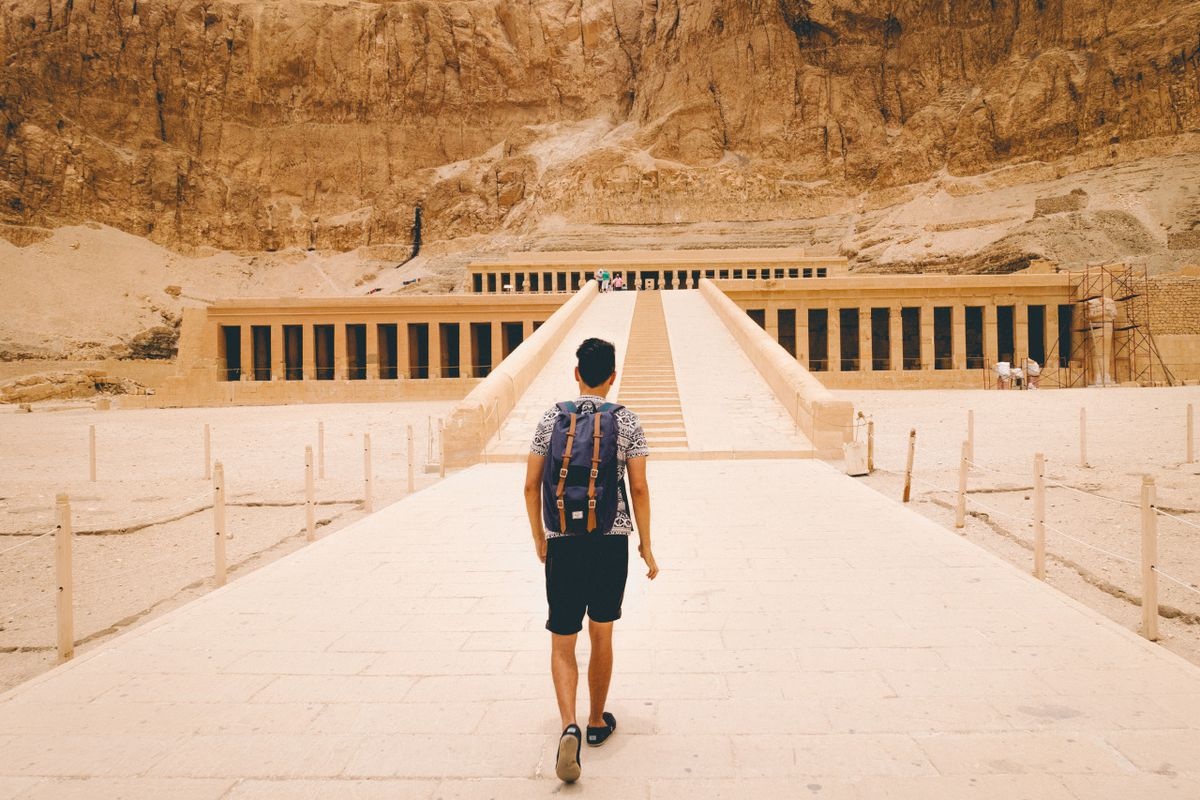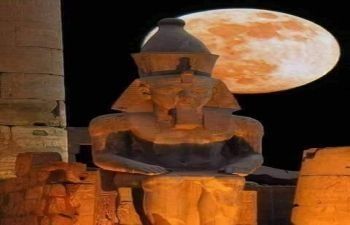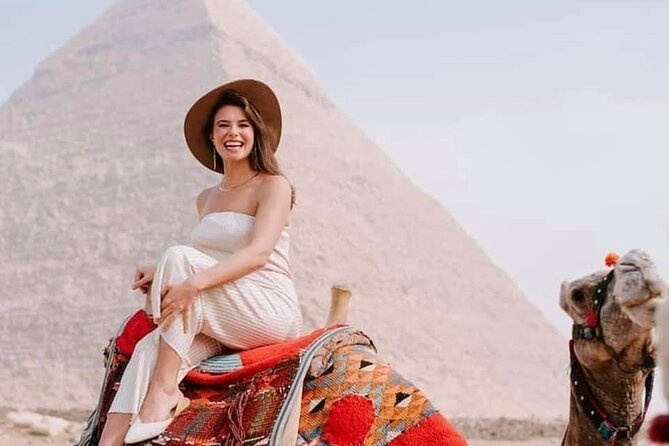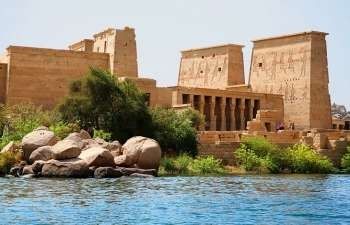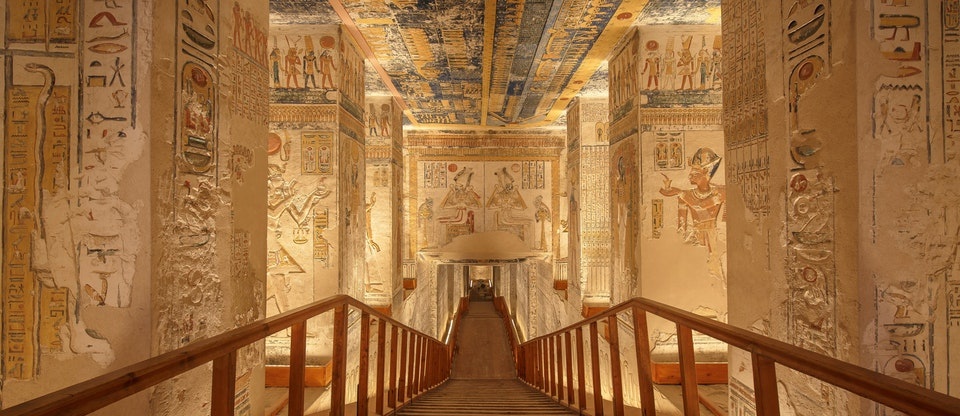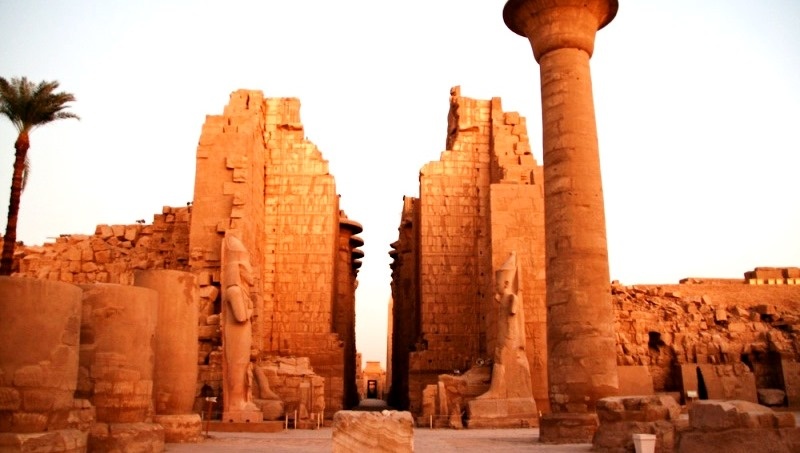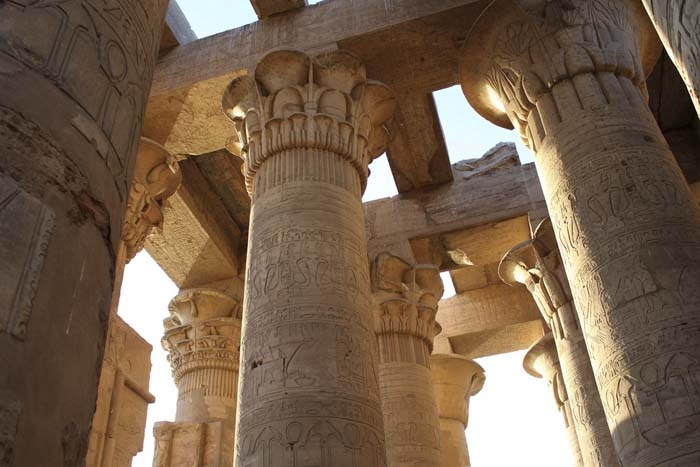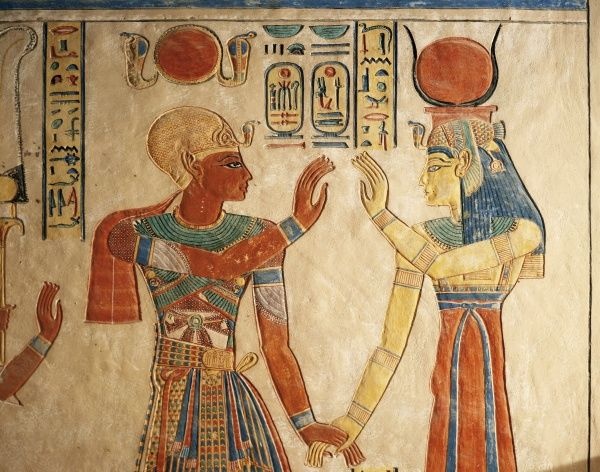Top 10 attracties in Luxor
Luxor is eigenlijk een openluchtmuseum, en er is geen betere plek in Egypte om een paar dagen te stoppen en jezelf gewoon te verliezen in de wonderen van de antieke wereld. Plan uw reis met onze lijst met de 10 belangrijkste toeristische attracties in en rond Luxor.
Top 10 attracties in Luxor
1- Karnak
temple
 Of all Luxor
's many monuments, the Temple Complex of Karnak
has to be its most astonishing and beautiful feat. Within its precincts are the Great Temple of Amun, the Temple of Khons, and the Festival Temple of Tuthmosis III, as well as many other buildings. It is not built to a single unified plan but represents the building activity of many successive rulers of Egypt, who vied with one another in adding to and adorning this great national sanctuary, which became the most important of Egypt's temples during the New Kingdom.
All the monuments here are on a gigantic scale, reducing visitors to ant-like proportions as they gaze up at mighty columns and colossal statuary. Even if you're short on time, don't scrimp on your visit here. You need at least three hours to try and make sense of the entire complex.
You can easily walk to Karnak
from downtown along the Nile-side Corniche road, although due to the heat, most people take a taxi. If you're short on time, plenty of tours are offered that whip you around the highlights of Karnak
. A private tour of Luxor
East Bank, Karnak
, and the Luxor
temples is a good option. This half-day tour visits these ancient sites with an Egyptologist.
2-Valley of the Kings
Of all Luxor
's many monuments, the Temple Complex of Karnak
has to be its most astonishing and beautiful feat. Within its precincts are the Great Temple of Amun, the Temple of Khons, and the Festival Temple of Tuthmosis III, as well as many other buildings. It is not built to a single unified plan but represents the building activity of many successive rulers of Egypt, who vied with one another in adding to and adorning this great national sanctuary, which became the most important of Egypt's temples during the New Kingdom.
All the monuments here are on a gigantic scale, reducing visitors to ant-like proportions as they gaze up at mighty columns and colossal statuary. Even if you're short on time, don't scrimp on your visit here. You need at least three hours to try and make sense of the entire complex.
You can easily walk to Karnak
from downtown along the Nile-side Corniche road, although due to the heat, most people take a taxi. If you're short on time, plenty of tours are offered that whip you around the highlights of Karnak
. A private tour of Luxor
East Bank, Karnak
, and the Luxor
temples is a good option. This half-day tour visits these ancient sites with an Egyptologist.
2-Valley of the Kings
 The famed Valley of the Kings, hidden between rocky escarpments, was the final resting place for the kings of the 18th, 19th, and 20th dynasties. Their main attraction is their wonderfully vivid wall paintings. Since it was believed that the dead man, accompanied by the sun god (or perhaps have become one with the sun god) sailed through the underworld at night in a boat, the walls of the tombs were adorned with texts and scenes depicting this voyage and giving the dead man instruction on its course.
Within the valley are 63 tombs, which are a roll-call of famous names of Egyptian history, including the famous boy-king Tutankhamun. The tombs are open on a rotation system to preserve the paintings as much as possible from the damage caused by humidity.
3- Luxor
temple
The famed Valley of the Kings, hidden between rocky escarpments, was the final resting place for the kings of the 18th, 19th, and 20th dynasties. Their main attraction is their wonderfully vivid wall paintings. Since it was believed that the dead man, accompanied by the sun god (or perhaps have become one with the sun god) sailed through the underworld at night in a boat, the walls of the tombs were adorned with texts and scenes depicting this voyage and giving the dead man instruction on its course.
Within the valley are 63 tombs, which are a roll-call of famous names of Egyptian history, including the famous boy-king Tutankhamun. The tombs are open on a rotation system to preserve the paintings as much as possible from the damage caused by humidity.
3- Luxor
temple
 Presiding over the modern downtown district, Luxor
Temple is an ode to the changing face of Egypt through the centuries. Built first by Amenophis III (on the site of an earlier sandstone temple), it was known as "the southern harem of Amun" and was dedicated to Amun, his consort Mut, and their son the moon god Khons. Like all Egyptian temples, it comprises the chapels of the deities with their vestibules and subsidiary chambers, a large Hypostyle Hall, and an open Peristyle Court, which was approached from the north by a great colonnade.
The temple was added to and changed by a parade of pharaohs, including Amenophis IV (who obliterated all references to the god Amun within the temple and added the Sanctuary of the god Aten), Tutankhamun (who had the walls of the colonnade embellished with reliefs and in turn destroyed the Temple of the Aten), Seti I (who restored the reliefs of Amun), and Ramses II (who extended the temple significantly, adding a new colonnaded court at the north end). During the Christian era, the temple underwent a transformation into a church, while in the Islamic period, the Mosque of Abu el-Haggag, dedicated to a revered holy man, was built inside the complex grounds.
4- Queen Hatshepsut
temple
Presiding over the modern downtown district, Luxor
Temple is an ode to the changing face of Egypt through the centuries. Built first by Amenophis III (on the site of an earlier sandstone temple), it was known as "the southern harem of Amun" and was dedicated to Amun, his consort Mut, and their son the moon god Khons. Like all Egyptian temples, it comprises the chapels of the deities with their vestibules and subsidiary chambers, a large Hypostyle Hall, and an open Peristyle Court, which was approached from the north by a great colonnade.
The temple was added to and changed by a parade of pharaohs, including Amenophis IV (who obliterated all references to the god Amun within the temple and added the Sanctuary of the god Aten), Tutankhamun (who had the walls of the colonnade embellished with reliefs and in turn destroyed the Temple of the Aten), Seti I (who restored the reliefs of Amun), and Ramses II (who extended the temple significantly, adding a new colonnaded court at the north end). During the Christian era, the temple underwent a transformation into a church, while in the Islamic period, the Mosque of Abu el-Haggag, dedicated to a revered holy man, was built inside the complex grounds.
4- Queen Hatshepsut
temple
 The Temple of Deir el-Bahri is magnificently situated at the foot of the sheer cliffs fringing the desert hills, the light-coloured, almost white, sandstone of the temple standing out prominently against the golden yellow to light brown rocks behind. The temple complex is laid out on three terraces rising from the plain, linked by ramps, which divide it into a northern and a southern half. Along the west side of each terrace is a raised colonnade.
The terraces were hewn out of the eastern slopes of the hills, with retaining walls of the finest sandstone along the sides and to the rear. The temple itself was also partly hewn from the rock. Inside, the complex is richly adorned with statues, reliefs, and inscriptions. Note how Queen Hatshepsut
had herself represented with the attributes of a male pharaoh (beard and short apron) to demonstrate that she possessed all the authority of a king.
5- Luxor
Museum
The Temple of Deir el-Bahri is magnificently situated at the foot of the sheer cliffs fringing the desert hills, the light-coloured, almost white, sandstone of the temple standing out prominently against the golden yellow to light brown rocks behind. The temple complex is laid out on three terraces rising from the plain, linked by ramps, which divide it into a northern and a southern half. Along the west side of each terrace is a raised colonnade.
The terraces were hewn out of the eastern slopes of the hills, with retaining walls of the finest sandstone along the sides and to the rear. The temple itself was also partly hewn from the rock. Inside, the complex is richly adorned with statues, reliefs, and inscriptions. Note how Queen Hatshepsut
had herself represented with the attributes of a male pharaoh (beard and short apron) to demonstrate that she possessed all the authority of a king.
5- Luxor
Museum
 One of Egypt's best museums, Luxor
Museum holds a beautifully exhibited collection from the local area, which tells the story of ancient Thebes from the Old Kingdom right up to the Islamic Period. The museum's prize possessions are the two Royal Mummies of Ahmose I and what is believed to be Ramses I in two rooms on the ground floor, which are worth a visit here alone.
The upper floor has a dazzling display of amulets, silver bowls, grave and tomb furnishings, and votive tablets running across the middle of the floor space. While here, check out the reliefs on the re-erected Wall of Akhenaten. The 283 sandstone blocks are covered with painted reliefs and originally belonged to Akhenaten's Temple of the Sun at Karnak
.
6- Madinet Habu Temple
One of Egypt's best museums, Luxor
Museum holds a beautifully exhibited collection from the local area, which tells the story of ancient Thebes from the Old Kingdom right up to the Islamic Period. The museum's prize possessions are the two Royal Mummies of Ahmose I and what is believed to be Ramses I in two rooms on the ground floor, which are worth a visit here alone.
The upper floor has a dazzling display of amulets, silver bowls, grave and tomb furnishings, and votive tablets running across the middle of the floor space. While here, check out the reliefs on the re-erected Wall of Akhenaten. The 283 sandstone blocks are covered with painted reliefs and originally belonged to Akhenaten's Temple of the Sun at Karnak
.
6- Madinet Habu Temple
 With the famous Valley of the Kings and Temple of Deir al-Bahri the main attractions, Medinet Habu often gets overlooked on a West Bank trip, but this is one of Egypt's most beautifully decorated temples and should be on everyone's West Bank hit list. The complex consists of a small, older temple built during the 18th dynasty and enlarged in the Late Period, and the great Temple of Ramses III, associated with a royal palace, which was surrounded by a battlemented enclosure wall four meters high.
The main temple area was built exactly on the model of the Ramesseum and, like the Ramesseum, was dedicated to Amun. The reliefs here are some of the best you'll see on the West Bank.
7- Tombes of the Nobles
With the famous Valley of the Kings and Temple of Deir al-Bahri the main attractions, Medinet Habu often gets overlooked on a West Bank trip, but this is one of Egypt's most beautifully decorated temples and should be on everyone's West Bank hit list. The complex consists of a small, older temple built during the 18th dynasty and enlarged in the Late Period, and the great Temple of Ramses III, associated with a royal palace, which was surrounded by a battlemented enclosure wall four meters high.
The main temple area was built exactly on the model of the Ramesseum and, like the Ramesseum, was dedicated to Amun. The reliefs here are some of the best you'll see on the West Bank.
7- Tombes of the Nobles
 If you haven't had your fill of tombs in the Valley of the Kings then make a beeline for the Tombs of the Nobles, which may be less famous, but actually include much better-preserved examples of tomb paintings. The site contains around 400 tombs of various dignitaries, which date roughly from the 6th dynasty right up to the Ptolemaic era.
The tomb paintings here aren't so concerned with guiding the dead into the afterlife; instead, they showcase scenes from Egyptian daily life. In particular, the Tomb of Sennofer, Tomb of Rekhmire, Tomb of Khonsu, Tomb of Benia, Tomb of Menna, and Tomb of Nakht are home to some of Egypt's most vivid and lively tomb paintings.
If you're short of time, opt to see the Tomb of Sennofer and Tomb of Rekhmire. Both have incredibly detailed paintings depicting scenes from the men's daily lives, work, and family life. Sennofer was an overseer during the reign of Amenhotep II, while Rekhmire was the pharaoh's vizier.
8- The Colossi of Memnon
If you haven't had your fill of tombs in the Valley of the Kings then make a beeline for the Tombs of the Nobles, which may be less famous, but actually include much better-preserved examples of tomb paintings. The site contains around 400 tombs of various dignitaries, which date roughly from the 6th dynasty right up to the Ptolemaic era.
The tomb paintings here aren't so concerned with guiding the dead into the afterlife; instead, they showcase scenes from Egyptian daily life. In particular, the Tomb of Sennofer, Tomb of Rekhmire, Tomb of Khonsu, Tomb of Benia, Tomb of Menna, and Tomb of Nakht are home to some of Egypt's most vivid and lively tomb paintings.
If you're short of time, opt to see the Tomb of Sennofer and Tomb of Rekhmire. Both have incredibly detailed paintings depicting scenes from the men's daily lives, work, and family life. Sennofer was an overseer during the reign of Amenhotep II, while Rekhmire was the pharaoh's vizier.
8- The Colossi of Memnon
 Beside the road that runs from the Valley of the Queens and Medinet Habu towards the Nile are the famous gigantic statues known as the Colossi of Memnon
. Carved out of hard yellowish-brown sandstone quarried in the hills above Edfu, they represent Amenophis III seated on a cube-shaped throne, and once stood guard at the entrance to the king's temple, of which only scanty traces are left. In Roman Imperial times they were taken for statues of Memnon
, son of Eos and Tithonus, who was killed by Achilles during the Trojan War.
The South Colossus is better preserved than the one to the north. It stands 19.59-meters high and the base is partly buried under the sand. With the crown that it originally wore but has long since vanished, the total height must have been some 21 meters.
The North Colossus is the famous "musical statue," which brought flocks of visitors here during the Roman Imperial period. Visitors observed that the statue emitted a musical note at sunrise and this gave rise to the myth that Memnon
was greeting his mother, Eos, with this soft, plaintive note. The sound ceased to be heard after Emperor Septimus Severus had the upper part of the statue restored.
If you walk behind the statues, you can see the vast site (currently being excavated by archaeologists) where Amenophis III's temple once sat.
9- Ramseum Temple
Beside the road that runs from the Valley of the Queens and Medinet Habu towards the Nile are the famous gigantic statues known as the Colossi of Memnon
. Carved out of hard yellowish-brown sandstone quarried in the hills above Edfu, they represent Amenophis III seated on a cube-shaped throne, and once stood guard at the entrance to the king's temple, of which only scanty traces are left. In Roman Imperial times they were taken for statues of Memnon
, son of Eos and Tithonus, who was killed by Achilles during the Trojan War.
The South Colossus is better preserved than the one to the north. It stands 19.59-meters high and the base is partly buried under the sand. With the crown that it originally wore but has long since vanished, the total height must have been some 21 meters.
The North Colossus is the famous "musical statue," which brought flocks of visitors here during the Roman Imperial period. Visitors observed that the statue emitted a musical note at sunrise and this gave rise to the myth that Memnon
was greeting his mother, Eos, with this soft, plaintive note. The sound ceased to be heard after Emperor Septimus Severus had the upper part of the statue restored.
If you walk behind the statues, you can see the vast site (currently being excavated by archaeologists) where Amenophis III's temple once sat.
9- Ramseum Temple
 The great mortuary temple built by Ramses II and dedicated to Amun lies on the edge of the cultivated land, some one-and-a-half kilometres south of Deir el-Bahri. Although only about half of the original structure survives, it is still a highly impressive monument. During the Roman Imperial period, it was known as the Tomb of Ozymandias, mentioned by the historian Diodorus (1st century BC) and was later immortalized by the English poet Shelley in his poem Ozymandias.
The north tower and south tower are inscribed with reliefs of Ramses II's battle with the Hittites, similar to the reliefs of Abu Simbel. On the South Tower, the whole of the left-hand half of the wall is taken up by the Battle of Qadesh. Scenes here portray Ramses in his chariot dashing against the Hittites, who are killed by his arrows or flee in wild confusion and fall into the River Orontes, while to the right, you can make out the Hittite Prince and the enemy fleeing into their fortress.
Inside the First, Court is the remains of a colossal figure of the king, which is estimated to have originally had a total height of 17.5 meters and to have weighed more than 1,000 tons.
10- The valley of the Queens
The great mortuary temple built by Ramses II and dedicated to Amun lies on the edge of the cultivated land, some one-and-a-half kilometres south of Deir el-Bahri. Although only about half of the original structure survives, it is still a highly impressive monument. During the Roman Imperial period, it was known as the Tomb of Ozymandias, mentioned by the historian Diodorus (1st century BC) and was later immortalized by the English poet Shelley in his poem Ozymandias.
The north tower and south tower are inscribed with reliefs of Ramses II's battle with the Hittites, similar to the reliefs of Abu Simbel. On the South Tower, the whole of the left-hand half of the wall is taken up by the Battle of Qadesh. Scenes here portray Ramses in his chariot dashing against the Hittites, who are killed by his arrows or flee in wild confusion and fall into the River Orontes, while to the right, you can make out the Hittite Prince and the enemy fleeing into their fortress.
Inside the First, Court is the remains of a colossal figure of the king, which is estimated to have originally had a total height of 17.5 meters and to have weighed more than 1,000 tons.
10- The valley of the Queens
 The tombs in the Valley of the Queens mostly belong to the 19th and 20th dynasties. A total of almost 80 tombs are now known, most of them excavated by an Italian expedition led by E. Schiaparelli between 1903 and 1905. Many of the tombs are unfinished and without decoration, resembling mere caves in the rocks. There are few incised inscriptions or reliefs, with much of the decoration consisting of paintings on stucco.
Only four tombs are open for public viewing, but one of the group is the famed Tomb of Queen Nefertari, only reopened in 2016, making a trip here well worth it. The Tomb of Queen Nefertari, Wife to Ramses II, is regarded as the finest of the West Bank's glut of tombs. The walls and ceilings of the chambers here are covered with dazzling, highly detailed and richly coloured scenes, which celebrate Nefertari's legendary beauty.
Of the three other tombs that can be seen here, the Tomb of Prince Amen-her-khopshef is the best, as the wall paintings of its chambers have well-preserved colours. A son of Ramses III, Amen-her-khopshef died while still a teenager.
If you have time, or simply just like tombs, the Tomb of Khaemwaset (another son of Ramses III) and the Tomb of Queen Titi both contain some interesting preserved scenes, though those in the Titi tomb are more faded than Khaemwaset. There is no consensus in the archaeology world over who Titi's husband was.
The tombs in the Valley of the Queens mostly belong to the 19th and 20th dynasties. A total of almost 80 tombs are now known, most of them excavated by an Italian expedition led by E. Schiaparelli between 1903 and 1905. Many of the tombs are unfinished and without decoration, resembling mere caves in the rocks. There are few incised inscriptions or reliefs, with much of the decoration consisting of paintings on stucco.
Only four tombs are open for public viewing, but one of the group is the famed Tomb of Queen Nefertari, only reopened in 2016, making a trip here well worth it. The Tomb of Queen Nefertari, Wife to Ramses II, is regarded as the finest of the West Bank's glut of tombs. The walls and ceilings of the chambers here are covered with dazzling, highly detailed and richly coloured scenes, which celebrate Nefertari's legendary beauty.
Of the three other tombs that can be seen here, the Tomb of Prince Amen-her-khopshef is the best, as the wall paintings of its chambers have well-preserved colours. A son of Ramses III, Amen-her-khopshef died while still a teenager.
If you have time, or simply just like tombs, the Tomb of Khaemwaset (another son of Ramses III) and the Tomb of Queen Titi both contain some interesting preserved scenes, though those in the Titi tomb are more faded than Khaemwaset. There is no consensus in the archaeology world over who Titi's husband was.
 Of all Luxor
's many monuments, the Temple Complex of Karnak
has to be its most astonishing and beautiful feat. Within its precincts are the Great Temple of Amun, the Temple of Khons, and the Festival Temple of Tuthmosis III, as well as many other buildings. It is not built to a single unified plan but represents the building activity of many successive rulers of Egypt, who vied with one another in adding to and adorning this great national sanctuary, which became the most important of Egypt's temples during the New Kingdom.
All the monuments here are on a gigantic scale, reducing visitors to ant-like proportions as they gaze up at mighty columns and colossal statuary. Even if you're short on time, don't scrimp on your visit here. You need at least three hours to try and make sense of the entire complex.
You can easily walk to Karnak
from downtown along the Nile-side Corniche road, although due to the heat, most people take a taxi. If you're short on time, plenty of tours are offered that whip you around the highlights of Karnak
. A private tour of Luxor
East Bank, Karnak
, and the Luxor
temples is a good option. This half-day tour visits these ancient sites with an Egyptologist.
2-Valley of the Kings
Of all Luxor
's many monuments, the Temple Complex of Karnak
has to be its most astonishing and beautiful feat. Within its precincts are the Great Temple of Amun, the Temple of Khons, and the Festival Temple of Tuthmosis III, as well as many other buildings. It is not built to a single unified plan but represents the building activity of many successive rulers of Egypt, who vied with one another in adding to and adorning this great national sanctuary, which became the most important of Egypt's temples during the New Kingdom.
All the monuments here are on a gigantic scale, reducing visitors to ant-like proportions as they gaze up at mighty columns and colossal statuary. Even if you're short on time, don't scrimp on your visit here. You need at least three hours to try and make sense of the entire complex.
You can easily walk to Karnak
from downtown along the Nile-side Corniche road, although due to the heat, most people take a taxi. If you're short on time, plenty of tours are offered that whip you around the highlights of Karnak
. A private tour of Luxor
East Bank, Karnak
, and the Luxor
temples is a good option. This half-day tour visits these ancient sites with an Egyptologist.
2-Valley of the Kings
 The famed Valley of the Kings, hidden between rocky escarpments, was the final resting place for the kings of the 18th, 19th, and 20th dynasties. Their main attraction is their wonderfully vivid wall paintings. Since it was believed that the dead man, accompanied by the sun god (or perhaps have become one with the sun god) sailed through the underworld at night in a boat, the walls of the tombs were adorned with texts and scenes depicting this voyage and giving the dead man instruction on its course.
Within the valley are 63 tombs, which are a roll-call of famous names of Egyptian history, including the famous boy-king Tutankhamun. The tombs are open on a rotation system to preserve the paintings as much as possible from the damage caused by humidity.
3- Luxor
temple
The famed Valley of the Kings, hidden between rocky escarpments, was the final resting place for the kings of the 18th, 19th, and 20th dynasties. Their main attraction is their wonderfully vivid wall paintings. Since it was believed that the dead man, accompanied by the sun god (or perhaps have become one with the sun god) sailed through the underworld at night in a boat, the walls of the tombs were adorned with texts and scenes depicting this voyage and giving the dead man instruction on its course.
Within the valley are 63 tombs, which are a roll-call of famous names of Egyptian history, including the famous boy-king Tutankhamun. The tombs are open on a rotation system to preserve the paintings as much as possible from the damage caused by humidity.
3- Luxor
temple
 Presiding over the modern downtown district, Luxor
Temple is an ode to the changing face of Egypt through the centuries. Built first by Amenophis III (on the site of an earlier sandstone temple), it was known as "the southern harem of Amun" and was dedicated to Amun, his consort Mut, and their son the moon god Khons. Like all Egyptian temples, it comprises the chapels of the deities with their vestibules and subsidiary chambers, a large Hypostyle Hall, and an open Peristyle Court, which was approached from the north by a great colonnade.
The temple was added to and changed by a parade of pharaohs, including Amenophis IV (who obliterated all references to the god Amun within the temple and added the Sanctuary of the god Aten), Tutankhamun (who had the walls of the colonnade embellished with reliefs and in turn destroyed the Temple of the Aten), Seti I (who restored the reliefs of Amun), and Ramses II (who extended the temple significantly, adding a new colonnaded court at the north end). During the Christian era, the temple underwent a transformation into a church, while in the Islamic period, the Mosque of Abu el-Haggag, dedicated to a revered holy man, was built inside the complex grounds.
4- Queen Hatshepsut
temple
Presiding over the modern downtown district, Luxor
Temple is an ode to the changing face of Egypt through the centuries. Built first by Amenophis III (on the site of an earlier sandstone temple), it was known as "the southern harem of Amun" and was dedicated to Amun, his consort Mut, and their son the moon god Khons. Like all Egyptian temples, it comprises the chapels of the deities with their vestibules and subsidiary chambers, a large Hypostyle Hall, and an open Peristyle Court, which was approached from the north by a great colonnade.
The temple was added to and changed by a parade of pharaohs, including Amenophis IV (who obliterated all references to the god Amun within the temple and added the Sanctuary of the god Aten), Tutankhamun (who had the walls of the colonnade embellished with reliefs and in turn destroyed the Temple of the Aten), Seti I (who restored the reliefs of Amun), and Ramses II (who extended the temple significantly, adding a new colonnaded court at the north end). During the Christian era, the temple underwent a transformation into a church, while in the Islamic period, the Mosque of Abu el-Haggag, dedicated to a revered holy man, was built inside the complex grounds.
4- Queen Hatshepsut
temple
 The Temple of Deir el-Bahri is magnificently situated at the foot of the sheer cliffs fringing the desert hills, the light-coloured, almost white, sandstone of the temple standing out prominently against the golden yellow to light brown rocks behind. The temple complex is laid out on three terraces rising from the plain, linked by ramps, which divide it into a northern and a southern half. Along the west side of each terrace is a raised colonnade.
The terraces were hewn out of the eastern slopes of the hills, with retaining walls of the finest sandstone along the sides and to the rear. The temple itself was also partly hewn from the rock. Inside, the complex is richly adorned with statues, reliefs, and inscriptions. Note how Queen Hatshepsut
had herself represented with the attributes of a male pharaoh (beard and short apron) to demonstrate that she possessed all the authority of a king.
5- Luxor
Museum
The Temple of Deir el-Bahri is magnificently situated at the foot of the sheer cliffs fringing the desert hills, the light-coloured, almost white, sandstone of the temple standing out prominently against the golden yellow to light brown rocks behind. The temple complex is laid out on three terraces rising from the plain, linked by ramps, which divide it into a northern and a southern half. Along the west side of each terrace is a raised colonnade.
The terraces were hewn out of the eastern slopes of the hills, with retaining walls of the finest sandstone along the sides and to the rear. The temple itself was also partly hewn from the rock. Inside, the complex is richly adorned with statues, reliefs, and inscriptions. Note how Queen Hatshepsut
had herself represented with the attributes of a male pharaoh (beard and short apron) to demonstrate that she possessed all the authority of a king.
5- Luxor
Museum
 One of Egypt's best museums, Luxor
Museum holds a beautifully exhibited collection from the local area, which tells the story of ancient Thebes from the Old Kingdom right up to the Islamic Period. The museum's prize possessions are the two Royal Mummies of Ahmose I and what is believed to be Ramses I in two rooms on the ground floor, which are worth a visit here alone.
The upper floor has a dazzling display of amulets, silver bowls, grave and tomb furnishings, and votive tablets running across the middle of the floor space. While here, check out the reliefs on the re-erected Wall of Akhenaten. The 283 sandstone blocks are covered with painted reliefs and originally belonged to Akhenaten's Temple of the Sun at Karnak
.
6- Madinet Habu Temple
One of Egypt's best museums, Luxor
Museum holds a beautifully exhibited collection from the local area, which tells the story of ancient Thebes from the Old Kingdom right up to the Islamic Period. The museum's prize possessions are the two Royal Mummies of Ahmose I and what is believed to be Ramses I in two rooms on the ground floor, which are worth a visit here alone.
The upper floor has a dazzling display of amulets, silver bowls, grave and tomb furnishings, and votive tablets running across the middle of the floor space. While here, check out the reliefs on the re-erected Wall of Akhenaten. The 283 sandstone blocks are covered with painted reliefs and originally belonged to Akhenaten's Temple of the Sun at Karnak
.
6- Madinet Habu Temple
 With the famous Valley of the Kings and Temple of Deir al-Bahri the main attractions, Medinet Habu often gets overlooked on a West Bank trip, but this is one of Egypt's most beautifully decorated temples and should be on everyone's West Bank hit list. The complex consists of a small, older temple built during the 18th dynasty and enlarged in the Late Period, and the great Temple of Ramses III, associated with a royal palace, which was surrounded by a battlemented enclosure wall four meters high.
The main temple area was built exactly on the model of the Ramesseum and, like the Ramesseum, was dedicated to Amun. The reliefs here are some of the best you'll see on the West Bank.
7- Tombes of the Nobles
With the famous Valley of the Kings and Temple of Deir al-Bahri the main attractions, Medinet Habu often gets overlooked on a West Bank trip, but this is one of Egypt's most beautifully decorated temples and should be on everyone's West Bank hit list. The complex consists of a small, older temple built during the 18th dynasty and enlarged in the Late Period, and the great Temple of Ramses III, associated with a royal palace, which was surrounded by a battlemented enclosure wall four meters high.
The main temple area was built exactly on the model of the Ramesseum and, like the Ramesseum, was dedicated to Amun. The reliefs here are some of the best you'll see on the West Bank.
7- Tombes of the Nobles
 If you haven't had your fill of tombs in the Valley of the Kings then make a beeline for the Tombs of the Nobles, which may be less famous, but actually include much better-preserved examples of tomb paintings. The site contains around 400 tombs of various dignitaries, which date roughly from the 6th dynasty right up to the Ptolemaic era.
The tomb paintings here aren't so concerned with guiding the dead into the afterlife; instead, they showcase scenes from Egyptian daily life. In particular, the Tomb of Sennofer, Tomb of Rekhmire, Tomb of Khonsu, Tomb of Benia, Tomb of Menna, and Tomb of Nakht are home to some of Egypt's most vivid and lively tomb paintings.
If you're short of time, opt to see the Tomb of Sennofer and Tomb of Rekhmire. Both have incredibly detailed paintings depicting scenes from the men's daily lives, work, and family life. Sennofer was an overseer during the reign of Amenhotep II, while Rekhmire was the pharaoh's vizier.
8- The Colossi of Memnon
If you haven't had your fill of tombs in the Valley of the Kings then make a beeline for the Tombs of the Nobles, which may be less famous, but actually include much better-preserved examples of tomb paintings. The site contains around 400 tombs of various dignitaries, which date roughly from the 6th dynasty right up to the Ptolemaic era.
The tomb paintings here aren't so concerned with guiding the dead into the afterlife; instead, they showcase scenes from Egyptian daily life. In particular, the Tomb of Sennofer, Tomb of Rekhmire, Tomb of Khonsu, Tomb of Benia, Tomb of Menna, and Tomb of Nakht are home to some of Egypt's most vivid and lively tomb paintings.
If you're short of time, opt to see the Tomb of Sennofer and Tomb of Rekhmire. Both have incredibly detailed paintings depicting scenes from the men's daily lives, work, and family life. Sennofer was an overseer during the reign of Amenhotep II, while Rekhmire was the pharaoh's vizier.
8- The Colossi of Memnon
 Beside the road that runs from the Valley of the Queens and Medinet Habu towards the Nile are the famous gigantic statues known as the Colossi of Memnon
. Carved out of hard yellowish-brown sandstone quarried in the hills above Edfu, they represent Amenophis III seated on a cube-shaped throne, and once stood guard at the entrance to the king's temple, of which only scanty traces are left. In Roman Imperial times they were taken for statues of Memnon
, son of Eos and Tithonus, who was killed by Achilles during the Trojan War.
The South Colossus is better preserved than the one to the north. It stands 19.59-meters high and the base is partly buried under the sand. With the crown that it originally wore but has long since vanished, the total height must have been some 21 meters.
The North Colossus is the famous "musical statue," which brought flocks of visitors here during the Roman Imperial period. Visitors observed that the statue emitted a musical note at sunrise and this gave rise to the myth that Memnon
was greeting his mother, Eos, with this soft, plaintive note. The sound ceased to be heard after Emperor Septimus Severus had the upper part of the statue restored.
If you walk behind the statues, you can see the vast site (currently being excavated by archaeologists) where Amenophis III's temple once sat.
9- Ramseum Temple
Beside the road that runs from the Valley of the Queens and Medinet Habu towards the Nile are the famous gigantic statues known as the Colossi of Memnon
. Carved out of hard yellowish-brown sandstone quarried in the hills above Edfu, they represent Amenophis III seated on a cube-shaped throne, and once stood guard at the entrance to the king's temple, of which only scanty traces are left. In Roman Imperial times they were taken for statues of Memnon
, son of Eos and Tithonus, who was killed by Achilles during the Trojan War.
The South Colossus is better preserved than the one to the north. It stands 19.59-meters high and the base is partly buried under the sand. With the crown that it originally wore but has long since vanished, the total height must have been some 21 meters.
The North Colossus is the famous "musical statue," which brought flocks of visitors here during the Roman Imperial period. Visitors observed that the statue emitted a musical note at sunrise and this gave rise to the myth that Memnon
was greeting his mother, Eos, with this soft, plaintive note. The sound ceased to be heard after Emperor Septimus Severus had the upper part of the statue restored.
If you walk behind the statues, you can see the vast site (currently being excavated by archaeologists) where Amenophis III's temple once sat.
9- Ramseum Temple
 The great mortuary temple built by Ramses II and dedicated to Amun lies on the edge of the cultivated land, some one-and-a-half kilometres south of Deir el-Bahri. Although only about half of the original structure survives, it is still a highly impressive monument. During the Roman Imperial period, it was known as the Tomb of Ozymandias, mentioned by the historian Diodorus (1st century BC) and was later immortalized by the English poet Shelley in his poem Ozymandias.
The north tower and south tower are inscribed with reliefs of Ramses II's battle with the Hittites, similar to the reliefs of Abu Simbel. On the South Tower, the whole of the left-hand half of the wall is taken up by the Battle of Qadesh. Scenes here portray Ramses in his chariot dashing against the Hittites, who are killed by his arrows or flee in wild confusion and fall into the River Orontes, while to the right, you can make out the Hittite Prince and the enemy fleeing into their fortress.
Inside the First, Court is the remains of a colossal figure of the king, which is estimated to have originally had a total height of 17.5 meters and to have weighed more than 1,000 tons.
10- The valley of the Queens
The great mortuary temple built by Ramses II and dedicated to Amun lies on the edge of the cultivated land, some one-and-a-half kilometres south of Deir el-Bahri. Although only about half of the original structure survives, it is still a highly impressive monument. During the Roman Imperial period, it was known as the Tomb of Ozymandias, mentioned by the historian Diodorus (1st century BC) and was later immortalized by the English poet Shelley in his poem Ozymandias.
The north tower and south tower are inscribed with reliefs of Ramses II's battle with the Hittites, similar to the reliefs of Abu Simbel. On the South Tower, the whole of the left-hand half of the wall is taken up by the Battle of Qadesh. Scenes here portray Ramses in his chariot dashing against the Hittites, who are killed by his arrows or flee in wild confusion and fall into the River Orontes, while to the right, you can make out the Hittite Prince and the enemy fleeing into their fortress.
Inside the First, Court is the remains of a colossal figure of the king, which is estimated to have originally had a total height of 17.5 meters and to have weighed more than 1,000 tons.
10- The valley of the Queens
 The tombs in the Valley of the Queens mostly belong to the 19th and 20th dynasties. A total of almost 80 tombs are now known, most of them excavated by an Italian expedition led by E. Schiaparelli between 1903 and 1905. Many of the tombs are unfinished and without decoration, resembling mere caves in the rocks. There are few incised inscriptions or reliefs, with much of the decoration consisting of paintings on stucco.
Only four tombs are open for public viewing, but one of the group is the famed Tomb of Queen Nefertari, only reopened in 2016, making a trip here well worth it. The Tomb of Queen Nefertari, Wife to Ramses II, is regarded as the finest of the West Bank's glut of tombs. The walls and ceilings of the chambers here are covered with dazzling, highly detailed and richly coloured scenes, which celebrate Nefertari's legendary beauty.
Of the three other tombs that can be seen here, the Tomb of Prince Amen-her-khopshef is the best, as the wall paintings of its chambers have well-preserved colours. A son of Ramses III, Amen-her-khopshef died while still a teenager.
If you have time, or simply just like tombs, the Tomb of Khaemwaset (another son of Ramses III) and the Tomb of Queen Titi both contain some interesting preserved scenes, though those in the Titi tomb are more faded than Khaemwaset. There is no consensus in the archaeology world over who Titi's husband was.
The tombs in the Valley of the Queens mostly belong to the 19th and 20th dynasties. A total of almost 80 tombs are now known, most of them excavated by an Italian expedition led by E. Schiaparelli between 1903 and 1905. Many of the tombs are unfinished and without decoration, resembling mere caves in the rocks. There are few incised inscriptions or reliefs, with much of the decoration consisting of paintings on stucco.
Only four tombs are open for public viewing, but one of the group is the famed Tomb of Queen Nefertari, only reopened in 2016, making a trip here well worth it. The Tomb of Queen Nefertari, Wife to Ramses II, is regarded as the finest of the West Bank's glut of tombs. The walls and ceilings of the chambers here are covered with dazzling, highly detailed and richly coloured scenes, which celebrate Nefertari's legendary beauty.
Of the three other tombs that can be seen here, the Tomb of Prince Amen-her-khopshef is the best, as the wall paintings of its chambers have well-preserved colours. A son of Ramses III, Amen-her-khopshef died while still a teenager.
If you have time, or simply just like tombs, the Tomb of Khaemwaset (another son of Ramses III) and the Tomb of Queen Titi both contain some interesting preserved scenes, though those in the Titi tomb are more faded than Khaemwaset. There is no consensus in the archaeology world over who Titi's husband was.








